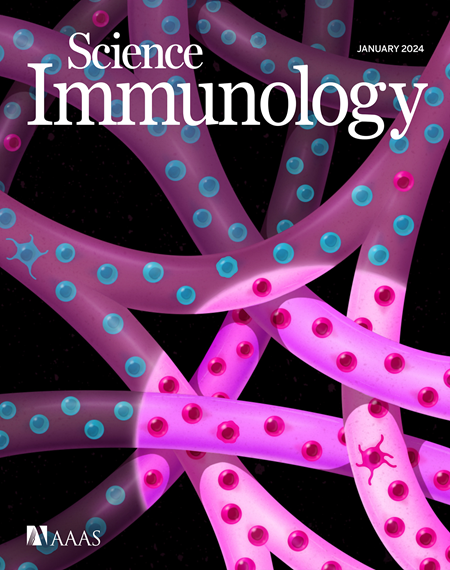Enkephalin-producing regulatory T cells in the skin restrain local inflammation through control of nociception
IF 16.3
1区 医学
Q1 IMMUNOLOGY
引用次数: 0
Abstract
The skin integrates diverse signals discerned by sensory neurons and immune cells to elicit adaptive responses to a range of stresses. Considering interactions between nervous and immune systems, we examined whether regulatory T (Treg) cells, which suppress systemic and local inflammation, can modulate activation of peripheral neurons. Acute Treg cell “loss of function” increased neuronal activation to noxious stimuli independently of their immunosuppressive function. This activity was mediated by a Treg cell subset capable of production of enkephalins encoded by the gene Penk, whose expression is facilitated by combined TCR and glucocorticoid receptor signaling. Punctual selective depletion of Penk-expressing Treg cells or specific ablation of Penk in Treg cells increased neuronal activation in response to noxious stimuli and associated inflammation. Our study indicates that a population of tissular Treg cells exhibits neuromodulatory activity to restrain local inflammation in the skin.

皮肤中产生脑啡肽的调节性T细胞通过控制伤害感觉来抑制局部炎症
皮肤整合了由感觉神经元和免疫细胞识别的各种信号,以引发对一系列压力的适应性反应。考虑到神经和免疫系统之间的相互作用,我们研究了抑制全身和局部炎症的调节性T (Treg)细胞是否可以调节周围神经元的激活。急性Treg细胞“功能丧失”增加了神经元对有害刺激的激活,独立于它们的免疫抑制功能。这种活性是由Treg细胞亚群介导的,能够产生由Penk基因编码的脑啡肽,其表达是由TCR和糖皮质激素受体联合信号传导促进的。表达Penk的Treg细胞的准时选择性耗竭或Treg细胞中Penk的特异性消融增加了对有害刺激和相关炎症反应的神经元激活。我们的研究表明,一群组织Treg细胞表现出神经调节活性,以抑制皮肤局部炎症。
本文章由计算机程序翻译,如有差异,请以英文原文为准。
求助全文
约1分钟内获得全文
求助全文
来源期刊

Science Immunology
Immunology and Microbiology-Immunology
CiteScore
32.90
自引率
2.00%
发文量
183
期刊介绍:
Science Immunology is a peer-reviewed journal that publishes original research articles in the field of immunology. The journal encourages the submission of research findings from all areas of immunology, including studies on innate and adaptive immunity, immune cell development and differentiation, immunogenomics, systems immunology, structural immunology, antigen presentation, immunometabolism, and mucosal immunology. Additionally, the journal covers research on immune contributions to health and disease, such as host defense, inflammation, cancer immunology, autoimmunity, allergy, transplantation, and immunodeficiency. Science Immunology maintains the same high-quality standard as other journals in the Science family and aims to facilitate understanding of the immune system by showcasing innovative advances in immunology research from all organisms and model systems, including humans.
 求助内容:
求助内容: 应助结果提醒方式:
应助结果提醒方式:


